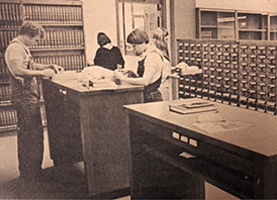When I first joined the CMU Libraries Cataloging Department in 1984, the library was a very different place than it is today. Sure, the building was smaller and had a faded 1960’s décor, but that wasn’t all. Another big difference was how manual everything was. Materials were ordered using slips of paper. Books were checked out with file cards. And, there was a card catalog. It held a set of cards for every item in the library collection. It was in alphabetical order and divided into three sections so that library patrons could search the drawers by author, title, or subject. And, it was huge, filling several large wooden cabinets on the second floor. The card catalog was the physical and intellectual centerpiece of the library.

Even in 1984, however, the card catalog was on its way to obsolescence. Staff in the Library Cataloging Department were still ordering cards for new materials but they were also putting the cataloging data on magnetic tapes. Massive projects were underway to put the cataloging data for all the older materials in the library on these same magnetic tapes. These projects had begun in the 1970’s. The tapes were stored in the vault of the Clarke Historical Library, then on the fourth floor.
The late 1980’s and early 1990’s were a time of transition as we moved from manual operations to automated ones. Once the vendor for our new integrated system was chosen, library staff became very busy planning, mapping data, testing, and organizing new workflows. There was no Library Systems Department at that time, so this was a significant learning experience for the library staff, many of whom had little or no computer expertise. The crucial moment was the loading of the data from the tapes into the new system. Some of them had been stored in the vault for several years and there was a lot of anxiety about the integrity of the data. Much to the relief of everyone, the tapes were in good shape. There were some glitches but overall, the cataloging data was fine and it loaded into the system as desired.
Over the course of the next few years, the new system allowed many library functions to be automated. Check-out and other circulation functions went online after a massive project to barcode the entire collection. Materials were ordered and received, and funds were tracked via the system. Most importantly, our online public access catalog, CENTRA, was born and in short order, the card catalog disappeared.
The first version of CENTRA, so innovative for its time, would be considered extremely primitive by today’s standards. For patrons and staff, it manifested itself as a series of monochrome “dumb terminals” that were linked by underground cable to a mainframe that was housed in Foust Hall. It wasn’t terribly reliable and staff of the nascent Library Systems Department did a lot of routine activities in order to keep it running. For library patrons, however, it offered many options that the card catalog hadn’t provided. For the first time, keyword searching was available. Patrons could see if a book was checked out before they hunted for it in the stacks. CENTRA also provided information about materials that were on order and about which issues of periodicals had arrived and when others were expected.
During the ensuing decades, a steady series of improvements took place. In the early 2000’s, around the same time the renovated and expanded Park Library re-opened, we chose a new vendor for our library system. Once again, we were migrating all of our catalog data. It was a lot of work but the process of migrating from one system to another was easier and a lot less harrowing than the original migration from the magnetic tapes. PC’s began to replace terminals in the library and along with this came the first web version of CENTRA. The web CENTRA had color and design options that were not previously available. More importantly, it had the capability to provide direct links from the catalog to online resources. As the library collection began to transition from physical to electronic during the 2000’s and 2010’s, direct access from the catalog to online resources became essential.
While all this innovation was taking place, the catalog data remained stored on a CMU server. In 2016, it became clear that it was time for a more up-to-date situation. A new vendor with a cloud based platform was chosen. The migration to this third library system took place in 2017. This system updates perpetually so change is ongoing. One of the consequences of adopting this new system is that there is no online public access catalog. As a result of this change, we said good-bye to CENTRA in 2017. Instead, the catalog data is integrated into a discovery tool called Smart Search. In Smart Search the catalog can be searched separately or together with other types of resources such as online periodical databases.

